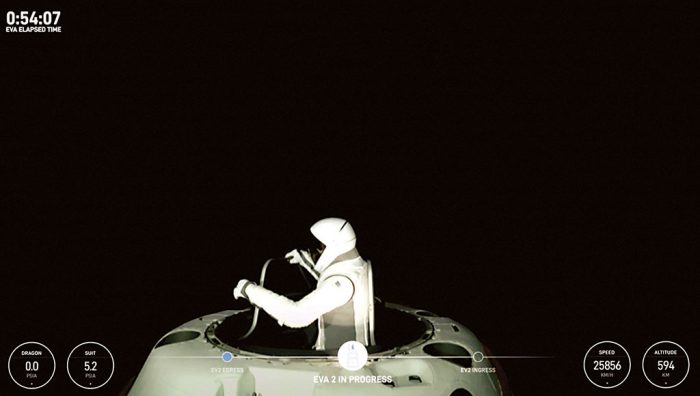In a groundbreaking moment for the commercial space industry, SpaceX’s Polaris Dawn mission made history on Thursday, as private civilians conducted spacewalks for the first time. Led by billionaire entrepreneur Jared Isaacman, the mission marked a significant leap forward in civilian space exploration.

The mission, which launched from Florida’s Kennedy Space Center on Tuesday, took the four-member crew deeper into space than any humans have ventured in 50 years. The spacecraft orbited Earth at an altitude of 430 miles, a feat not achieved since NASA’s Apollo program. On Thursday, the crew’s spacewalk commenced as oxygen flowed into their spacesuits, and Isaacman exited the Dragon spacecraft to begin their extravehicular activity (EVA).
From the spacecraft, Isaacman marveled at the view of Earth, saying, “It’s gorgeous,” as he gripped a structure called “Skywalker,” designed with handholds and footholds for ease of movement in space. Meanwhile, mission control in Hawthorne, California, cheered the successful milestone.
This mission solidifies SpaceX’s role as a leader in space exploration. The company, founded by Elon Musk in 2002, was initially met with skepticism from the space industry but has since revolutionized space travel. In 2020, SpaceX successfully launched NASA astronauts to the International Space Station, beating aerospace giant Boeing in crewed space missions. It now launches more rockets than any competitor and provides global internet services through its Starlink satellite network.
Before exiting the spacecraft, Isaacman and fellow SpaceX engineer Sarah Gillis performed mobility tests on the new-generation space suits, featuring heads-up displays, helmet cameras, and enhanced joint mobility. They also completed a vital “prebreathe” process to prevent decompression sickness before their spacewalk. Mission pilot Scott Poteet and SpaceX engineer Anna Menon stayed inside the Dragon capsule to monitor support systems, as the crew faced the risks of operating in the vacuum of space.
The Dragon capsule lacks a traditional airlock, meaning the entire crew was exposed to the vacuum of space during the EVA, unlike previous spacewalks where astronauts relied on tethers or jetpacks. The crew’s spacewalk has been compared to the pioneering efforts of early aviators, with former NASA administrator Sean O’Keefe calling it a “watershed event” in the ongoing commercialization of space.
The Polaris Dawn mission also included a first-of-its-kind journey into the inner Van Allen radiation belt, reaching an altitude of 870 miles—more than three times higher than the International Space Station. The team, which trained for over two years, continues to carry out a series of tasks, including testing laser-based satellite communications with SpaceX’s Starlink constellation and conducting scientific experiments.
The Polaris Dawn mission is part of a three-mission collaboration between Isaacman and SpaceX. The final mission aims to be the first crewed flight of SpaceX’s Starship, the rocket intended for Musk’s ambitious plans to colonize Mars. Financial terms of this collaboration remain undisclosed, but Isaacman is believed to have invested $200 million in the 2021 all-civilian SpaceX Inspiration4 mission.

